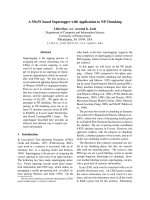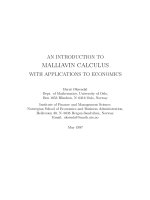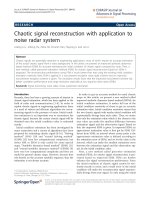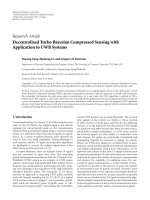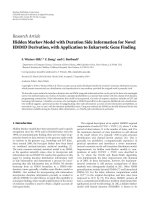focal press digital image processing with application to digital cinema first edition dec 2005 ebook - ddu
Bạn đang xem bản rút gọn của tài liệu. Xem và tải ngay bản đầy đủ của tài liệu tại đây (11.23 MB, 399 trang )
Digital Image Processing
with Application to Digital Cinema
G1
K80729-PR.qxd 10/27/05 2:20 PM Page i
K80729-PR.qxd 10/27/05 2:20 PM Page ii
G1
Digital Image Processing
with Application to Digital Cinema
By
K. S. Thyagarajan
AMSTERDAM • BOSTON • HEIDELBERG • LONDON
NEW YORK • OXFORD • PARIS • SAN DIEGO
SAN FRANCISCO • SINGAPORE • SYDNEY • TOKYO
Focal Press is an imprint of Elsevier
K80729-PR.qxd 10/27/05 2:20 PM Page iii
Acquisitions Editor Angelina Ward
Project Manager Paul Gottehrer
Assistant Editor Rachel Epstein
Marketing Manager Christine Veroulis
Cover Design Cate Barr
Interior Design Julio Esperas
Focal Press is an imprint of Elsevier
30 Corporate Drive, Suite 400, Burlington, MA 01803, USA
Linacre House, Jordan Hill, Oxford OX2 8DP, UK
Copyright © 2006, Elsevier Inc. All rights reserved.
No part of this publication may be reproduced, stored in a retrieval system, or transmitted in any
form or by any means, electronic, mechanical, photocopying, recording, or otherwise, without the
prior written permission of the publisher.
Permissions may be sought directly from Elsevier’s Science & Technology Rights
Department in Oxford, UK: phone: (+44) 1865 843830, fax: (+44) 1865 853333, E-mail:
You may also complete your request on-line via the Elsevier homepage
(), by selecting “Support & Contact” then “Copyright and Permission” and
then “Obtaining Permissions.”
Recognizing the importance of preserving what has been written, Elsevier prints its books on acid-
free paper whenever possible.
Library of Congress Cataloging-in-Publication Data
Application submitted
British Library Cataloguing-in-Publication Data
A catalogue record for this book is available from the British Library.
ISBN 13: 978-0-240-80729-4
ISBN 10: 0-240-80729-4
For information on all Focal Press publications visit our website at www.books.elsevier.com
050607080910 10987654321
Printed in Canada
Working together to grow
libraries in developing countries
www.elsevier.com | www.bookaid.org | www.sabre.org
K80729-PR.qxd 10/27/05 2:20 PM Page iv
In memory of my beloved parents.
G1
K80729-PR.qxd 10/27/05 2:20 PM Page v
K80729-PR.qxd 10/27/05 2:20 PM Page vi
Contents
G1
Preface xv
Introduction xix
1 Introduction 1
1.1 Background 1
1.2 Enhancement 1
1.3 Compression 4
1.4 Restoration 6
1.5 Computed Tomography 8
1.6 Image Analysis 8
1.7 Summary 11
References 11
2 Two-Dimensional Signals, Systems, and Discrete Fourier
Transform 13
2.1 Two-Dimensional Discrete Signals 13
2.2 Two-Dimensional Discrete Systems 15
2.2.1 Linear Systems 15
2.2.2 Space Invarient Systems 16
2.2.3 System Response via 2-D Convolution 16
2.2.4 Causal and Stable Systems 17
K80729-PR.qxd 10/27/05 2:20 PM Page vii
2.3 Two-Dimensional Discrete Fourier Transform 17
2.4 Frequency Response 19
2.5 Two-Dimensional Filtering 23
2.6 FIR Filter Design 27
2.6.1 Separable FIR Filters 27
2.6.1.1 Window-Based Methods 27
2.6.1.2 Frequency Sampling Technique 39
2.6.1.3 Optimal Design Techniques 40
2.6.2 Nonseparable FIR Filters 41
2.7 Summary 44
References 44
3 Human Visual Perception 47
3.1 Introduction 47
3.2 Brightness Perception 47
3.2.1 Intensity, Luminance, and Brightness 47
3.2.2 Simultaneous Contrast 50
3.2.3 Mach Bands 52
3.2.4 Transfer Function of the HVS 54
3.2.5 Monochrome Vision Model 55
3.2.6 Visual Masking and an Improved HVS Model 57
3.3 Color Perception 59
3.3.1 Color-Matching Functions 61
3.3.2 Color Coordinate Systems 63
3.3.2.1 CIE XYZ Primaries 64
3.3.2.2 NTSC Receiver and Transmission Primaries 66
3.3.3 HVS Model for Color Vision 69
3.3.4 Opponent Color Model 70
3.4 Summary 70
References 71
4 Image Acquisition 73
4.1 Introduction 73
4.2 Image Sensors 73
4.2.1 CCD Sensors 74
Contents
viii
K80729-PR.qxd 10/27/05 2:20 PM Page viii
4.2.1.1 Full-Frame Architecture 76
4.2.1.2 Interline Architecture 76
4.2.1.3 Frame-Transfer CCD 77
4.2.2 CMOS Sensors 79
4.2.3 Color Sensors 79
4.3 Image Sampling 82
4.4 Image Quantization 87
4.4.1 Uniform Quantization 87
4.4.2 Optimal Quantization 88
4.5 Image Scanning 90
4.5.1 Interlaced and Progressive Scanning 90
4.5.2 Color Image Scanning 91
4.5.3 Color Encoding in Digital Video 91
4.6 Film-to-Digital Conversion 93
4.7 Summary 94
References 95
5 Image Inhancement 97
5.1 Background 97
5.2 Point Processing 97
5.2.1 Logarithmic Transformation 98
5.2.2 Contrast Stretching 98
5.2.3 Histogram Modification 101
5.2.3.1 Histogram Equalization 101
5.2.3.2 Adaptive Histogram Modification 104
5.3 Neighborhood Processing 104
5.3.1 Simple Mask Operations 106
5.3.2 Two-Dimensional Filters Satisfying Specified Frequency
Responses 109
5.3.3 Median Filtering 111
5.4 Color Image Enhancement 117
5.5 Summary 120
References 121
Contents
ix
G1
K80729-PR.qxd 10/27/05 2:20 PM Page ix
6 Discrete Transforms for Image Processing 123
6.1 Introduction 123
6.2 Unitary Transforms 123
6.2.1 One-Dimensional Unitary Transforms 123
6.2.1.1 One-Dimensional DFT 124
6.2.1.2 One-Dimensional Discrete Cosine Transform (DCT) 125
6.2.1.3 One-Dimensional Discrete Sine Transform (DST) 126
6.2.1.4 One-Dimensional Discrete Hartley Transform 127
6.2.1.5 Hadamard, Haar, and Slant Transforms 128
6.2.2 Two-Dimensional Discrete Transforms 133
6.2.3 Some Properties of Discrete Unitary Transform 137
6.3 Karhunen-Loeve Transform 140
6.4 Choice of a Transform 144
6.5 Summary 144
References 144
7 Wavelet Transform 147
7.1 Introduction 147
7.2 Continuous Wavelet Transform 149
7.3 The Wavelet Series 151
7.4 Discrete Wavelet Transform 160
7.5 Implementation of the Discrete Wavelet Transform 160
7.6 Relationship of Scaling and Wavelet Filters to Wavelets 164
7.6.1 Orthogonal Discrete Wavelet Transform 166
7.6.2 Biorthogonal Discrete Wavelet Transform 168
7.6.3 Construction of Wavelets 171
7.7 Two-Dimensional Discrete Wavelet Transform 171
7.8 Summary 189
References 189
8 Image Compression 193
8.1 Introduction 193
8.1.1 Image Fidelity Criterion 197
Contents
x
K80729-PR.qxd 10/27/05 2:20 PM Page x
8.1.1.1 Quantitative Measures 197
8.1.1.2 Subjective Measures 198
8.2 Lossless Compression 199
8.2.1 Elements of Information Theory 199
8.2.2 Huffman Coding 202
8.2.3 Run-Length Coding 205
8.2.4 Arithmetic Coding 206
8.2.5 Golomb–Rice (GR) Coding 208
8.3 Predictive Coding 212
8.3.1 One-Dimensional DPCM 212
8.3.2 Adaptive DPCM 215
8.3.3 Two-Dimensional DPCM 218
8.4 Transform Coding 218
8.4.1 Choice of a Transform 220
8.4.2 Optimal Bit Allocation 220
8.4.3 Quantizer Design 222
8.4.4 Entropy Coder 226
8.4.5 Variable Block Size DCT Coder 230
8.5 Compression in the Wavelet Domain 231
8.5.1 Choice of Wavelets 232
8.5.2 Quantization 234
8.5.3 Zero-Tree Wavelet Coding 234
8.5.4 JPEG2000 Standard 244
8.6 Video Coding Principles 255
8.6.1 Temporal Prediction in the Pixel Domain 256
8.6.1.1 Motion Estimation 256
8.6.2 Wavelet-Based Interframe Coding 259
8.6.3 Interframe Coding Using Three-Dimensional DCT 260
8.6.3.1 Temporal Depth 261
8.6.3.2 Three-Dimensional DCT 261
8.6.3.3 Quantization 262
8.6.3.4 Zigzag Scanning 263
8.6.3.5 Entropy Coding 263
8.6.4 Role of Human Visual Perception in Image and Video Coding 263
8.6.4.1 Quantization Matrix for DCT Domain Coding 263
8.6.4.2 Quantization Matrix for Wavelet Domain Coding 265
8.6.4.3 Use of Spatial and Temporal Masking Models 266
8.6.5 MPEG Standard 270
Contents
xi
G1
K80729-PR.qxd 10/27/05 2:20 PM Page xi
8.7 Summary 278
References 280
9 Application of Image Compression to Digital Cinema 285
9.1 Introduction 285
9.2 Digital Cinema Technology Requirements 285
9.2.1 Image Resolution and Format 285
9.2.2 Digital Projector 286
9.2.3 Image Compression System 287
9.3 Case Study 289
9.3.1 QUALCOMM’s Digital Cinema System 289
9.3.1.1 Adaptive Block-Size DCT Encoder 290
9.3.1.2 ABSDCT Decoder 292
9.3.1.3 QUALCOMM’s Decoder ASIC 292
9.3.2 Digital Cinema Using Motion JPEG2000 Standard 295
9.3.2.1 MJ2K Image Resolution and Format 205
9.3.2.2 Compression in the Wavelet Domain 295
9.3.2.3 MJ2K File Format 205
9.3.2.4 Error Resilience 296
9.4 Concluding Remarks 297
References 298
Appendices
A Continuous and Discrete Fourier Transforms 301
A.1 Continuous Fourier Transform 301
A.1.1 Properties of Continuous Fourier Transform 302
A.2 Discrete Fourier Transform 303
B Radiometric and Photometric Quantities 305
B.1 Radiometric Quantities 305
B.1.1 Radiant Energy 305
B.1.2 Radiant Flux 305
Contents
xii
K80729-PR.qxd 10/27/05 2:20 PM Page xii
B.1.3 Radiant Exitance 305
B.1.4 Irradiance 305
B.1.5 Radiant Intensity 306
B.1.6 Radiance 306
B.2 Photometric Quantities 306
B.2.1 Luminous Flux 306
B.2.2 Lumens 307
B.2.3 Luminous Intensity 307
B2.4. Luminance 307
B2.5 Illumanation 308
C MATLAB M Files for Selected Chapters 309
C.1 M Files from Chapter 2 309
C.2 M Files from Chapter 3 313
C.3 M Files from Chapter 4 317
C.4 M Files from Chapter 5 318
C.5 M Files from Chapter 6 331
C.6 M Files from Chapter 7 340
C.7 M Files from Chapter 8 346
D Suggested MATLAB-Oriented Projects 367
D.1 Projects in Chapter 2 367
D.2 Projects in Chapter 3 368
D.3 Projects in Chapter 5 368
D.4 Projects in Chapter 8 369
Index 371
Contents
xiii
G1
K80729-PR.qxd 10/27/05 2:20 PM Page xiii
K80729-PR.qxd 10/27/05 2:20 PM Page xiv
Preface
G1
Digital image processing is a matured field but continues to advance due to the
availability of super fast PCs and fairly inexpensive memory devices. The rapid
growth in the use of multimedia over wireless and Internet highways has paved
the way for highly efficient image and video compression systems. Medical
imaging is another field that prompts the use of scientific image sensors of high
dynamic range along with innovative processing algorithms. With the advance-
ment of both sensor and display technologies and other transmission media,
time has come to deploy high quality, efficient, compression and distribution
techniques for the digital delivery of movies to theaters.
This book grew out of the author’s class notes on digital signal and
image processing courses taught at San Diego State University as well as his
industrial experience. The book aims predominantly at the working profes-
sionals in the field of digital imaging. However, the book is also suitable for
senior undergraduate and first year graduate students in electrical engineer-
ing, supplemented with some additional materials. Derivations are kept to a
minimum so as not to lose sight of the main theme. Numerous examples are
provided to illustrate various digital processes as well as their effects on the
processes. MATLAB tools are used throughout to generate all the figures, tables,
and images. Two chapters receive greater emphasis, which are hard to find in
standard textbooks. The chapter on human visual perception emphasizes
the importance of not only the familiar spatial and temporal visual phenomena
such as contrast sensitivity but also the spatial and temporal masking effects
through the use of a more refined nonlinear model. These models are useful
in image and video compression. The chapter on image compression is fairly
extensive though not exhaustive and includes spatial, transform, and wavelet
domain algorithms in greater detail. Compression based on wavelet transform
includes zero-tree embedded coding, which is fairly a recent concept. A separate
K80729-PR.qxd 10/27/05 2:20 PM Page xv
section is devoted to the use of human vision model in the compression
process.
Though there are numerous applications of digital image processing tech-
niques, this book aims at one particular but recent application, namely the digital
cinema. Currently digital projectors with very high contrast ratios are available
in the market and are highly suitable for projecting feature movies in theaters.
Image and video compression techniques have advanced to such a level wherein
near lossless visual quality is practical. Thus it is appropriate to put together
various compression, security, and projection technologies to design a digital
cinema system. Case studies include Qualcomm’s adaptive block size DCT-based
digital cinema system and a system based on Motion JPEG2000 with MPEG4-
based file format.
As the field of digital image processing is vast, the author decided not to
include topics related to computer vision. Computer vision in itself is worth a
whole book to cover. However, basic edge detection methods are included in the
introductory chapter, which is hoped to motivate earnest readers to go further
into computer vision. Book Organization Salient features of some of the chap-
ters are as follows:
BOOK ORGANIZATION
Chapter 1 introduces the readers to a plethora of digital processing techniques
by way of examples and brief descriptions. Chapter 2 is more of a review of two-
dimensional discrete signals and systems. Keeping in mind the target audience,
mathematical derivations are omitted. But it is unavoidable to introduce some
mathematical preliminaries at the earlier part of the book. However, impatient
readers may skip Chapter 2 without losing sight of the various processing tech-
niques to be introduced later.
Chapter 3 describes the human visual perception from a system’s point of
view. Human vision plays a key role in the design of image and video compres-
sion and display systems. Therefore, the chapter describes vision models in
detail, in particular the model that predicts masking effects in digital imaging.
Discrete wavelet transform is introduced in Chapter 6. Without derivations
and proof, the computation of the DWT using the familiar subband coding
scheme is described and illustrated with examples. The chapter also explains
the connection between wavelets and quadrature mirror filters and shows
how to compute a wavelet function from the analysis and synthesis filters with
examples.
Preface
xvi
K80729-PR.qxd 10/27/05 2:20 PM Page xvi
Chapter 8 is devoted to the discussion on image and video compression
techniques. This rather lengthy chapter develops various ideas involved in both
transform- and wavelet-based methods. Under wavelet-based compression, new
compression tools such as zero-tree embedded coder are described. It also
describes the basic ideas used in JPEG2000 and MPEG2 standards. MPEG2
standard is not discussed in length since the case studies considered don’t
require MPEG2.
Chapter 9 pertains to the case study of digital cinema system. More specifi-
cally, two case studies are covered. One is Qualcomm’s ABSDCT-based digital
cinema system and the other based on Motion JPEG2000 standard. These two
systems are very interesting because the former uses DCT as the compression
vehicle while the latter uses DWT for compression. This chapter also includes
some characteristics of digital projectors.
NOTE TO THE PROFESSIONALS
Those who find Chapter 2 to be hard to grasp can skip it and continue with the
rest of the book without losing anything. The intent to include this chapter was
to make the book more complete. For those serious-minded readers, it may be
beneficial to brush up on basic digital signal processing definitions and termi-
nologies to get a good grasp of the subject matter. As an incentive to an apt
reader, some possible projects are listed in one of the appendices. They may,
in fact, be more suitable to students. All these projects are solvable through
MATLAB tools. Another appendix lists MATLAB M files that generate the various
figures and tables in the book. Perhaps, these M files could be used as templates
to carry out the listed projects.
NOTE TO THE INSTRUCTORS
The book is suitable for one semester senior undergraduate and first-year grad-
uate students or selected topics for one quarter. No exercises are given at
the end of the chapters. Therefore the instructor should supplement lectures
with some problems to be solved. The MATLAB projects could serve as term
projects.
“Because when there is duality, as it were, then one smells something, one
sees something, one hears something, one speaks something, one thinks
Preface
xvii
G1
K80729-PR.qxd 10/27/05 2:20 PM Page xvii
something, one knows something. (But) when to the knower of Brahman every-
thing has become the Self, then what should one smell and through what, what
should one see and through what, what should one hear and through what, what
should one speak and through what, what should one think and through
what, what should one know and through what? Through what should one know
That owing to which all this is known—through what, O Maitreyı¯, should one
know the Knower?”
Verse II.iv.14 from the Br¸hada¯ran¸yaka Upanishad
Preface
xviii
K80729-PR.qxd 10/27/05 2:20 PM Page xviii
Acknowledgments
G1
I would like to thank the following people who have influenced the writing of
this book.
My sincere and special thanks to Dr. Andrew J. Viterbi for writing the preface
for this book. This book would not have been possible without the experience I
gained under his guidance, support and encouragement at QUALCOMM.
My sincere thanks to Steve A. Morley of QUALCOMM with whom I had the
opportunity to work in developing video compression technology for digital
cinema. His initial review of the book and his feedback on Chapter 9 were
extremely helpful. His support throughout the writing of this book is deeply
appreciated.
I have collaborated with Dr. Kesh Bakhru of Cubic Corp. on many projects
and proposal writings in the area of digital signal and image processing. He has
been my mentor and a great friend throughout my career in San Diego. I wish
to offer my heartfelt thanks to him for his initial review of the book and his
encouragement.
I also wish to thank my former colleagues at San Diego State University: Dr.
Leonard Marino who was always willing to be the co-chair for my graduate stu-
dents’ theses, Fred Harris for his continued support towards my professional
growth, and Dr. Huseyin Abut with whom I have worked in many research proj-
ects, including the one where I got introduced to image processing. I also wish
to thank all my students, whose feedback helped me improve my knowledge.
My very special thanks to Arjun Jain, VP, Micro USA for giving me encour-
agement and support throughout the course of writing this book.
I am very grateful to Rick Patterson, my distinguished colleague at Micro
USA, who has helped me enormously by constantly engaging me in fruitful dis-
cussions on DSP, image sensors and optics and also for his constant caring about
the outcome of this book.
K80729-PR.qxd 10/27/05 2:20 PM Page xix
My thanks to Steve Wicks, my other respected colleague at Micro USA, for
helping me prepare some of the diagrams.
I wish to thank Barry Sandrew, Ph.D. of Legend Films, for reviewing the man-
uscript in the midst of his hectic work.
I would like to sincerely thank Focal Press, an imprint of Elsevier Inc., for
publishing my book. My special thanks to Lothlorien Homet, Angelina Ward,
Becky Golden-Harrell, Rachel Epstein, and Paul Gottehrer of Focal Press for
overseeing the book project, and all others at Focal Press who helped me towards
the manuscript.
I greatly appreciate the generous grant from MathWorks, Inc. in the form
of MATLAB software tools.
My very special thanks to my son, Vikram Rajan, M.D., who encouraged me
tremendously by giving me constructive comments and suggestions to improve
the contents of the book.
Most of all, I owe my gratitude to my wonderful and talented wife Vasu who
said to me one day, “Thyag, why don’t you write a book on image processing?”
Without her love, sacrifices, constant encouragement, cooperation, patience,
and editing assistance, I would not have been able to write this book in a million
years.
K.S. Thyagarajan
October 2005
Acknowledgments
xx
K80729-PR.qxd 10/27/05 2:20 PM Page xx
H
Introduction
1.1 BACKGROUND
With the advent of digital computers in the 1960s dawned the era of digital signal
processing and digital image processing. Processing in the early days was off line
since the computers were not powerful enough. With the introduction of PCs
in the 1980s, the field of digital image processing started to mature. Now that
ultrahigh-speed PCs with almost unlimited internal memory are in the market
at affordable price ranges, digital image processing is a household name.
Digital image processing refers to any computer method—software or hard-
ware—by which the properties of an image are altered to satisfy certain objec-
tives. Obviously, the original image must be in digital format so that it can be
manipulated using a computer. Only software-oriented approaches are dealt
with in this book. Depending on the properties altered, digital image process-
ing techniques fall under different categories. A broad classification of the field
of digital image processing is exemplified in Figure 1-1. These classes of pro-
cessing methods are outlined briefly in the following.
1.2 ENHANCEMENT
Image enhancement refers to any process by which the visual quality of an image
is improved. Because there could be significant variations in the acquired images
due to varying lighting conditions, camera types, and so on, there are no set pro-
cedures to be adopted in image enhancement. Generally speaking, enhance-
ment techniques are ad hoc in nature. For example, if the original image lacks
sharpness, a suitable algorithm called unsharp masking can be designed so that
the subjective quality of the original image is improved by increasing its sharp-
ness without altering its other qualities. Figure 1-2a shows an original image, and
a sharpened version of it is shown in Figure 1-2b. Clearly, the enhanced image
looks much sharper, although a bit grainy. Another application of image
enhancement may arise when the original image is acquired under poor
lighting conditions. The image in this case may appear to lack details. Again, by
1
CHAPTER
K80729-Ch001.qxd 10/27/05 2:21 PM Page 1
applying a suitable enhancement procedure, the details can be restored. This
type of enhancement is termed histogram equalization. An example of such a
process is shown in Figure 1-3b. The original image appears in Figure 1-3a. Note
that the processed image brings out much more details that are not seen in the
original image. Moreover, the overall contrast has also been improved.
Enhancing medical images requires techniques somewhat different from
those used in Figures 1-2 and 1-3. Medical images usually lack contrast and the
delineating boundaries are not sharp. Figure 1-4a shows an original MRI image
and an enhanced version of it in Figure 1-4b. Note how the edges are well pre-
served and how details are visible that are not clear in the original image.
1 Introduction
2
Image Processing
Image Enhancement
Image Compression
Image Restoration
Image Analysis
Image Reconstruction
from projection
Spatial Domain
Techniques
Frequency Domain
Techniques
Lossless
Compression
Lossy
Compression
FIGURE
1-1
A broad classification of image processing methods.
ba
FIGURE
1-2
Sharpening an image: (a) original and (b) sharpened.
K80729-Ch001.qxd 10/27/05 2:21 PM Page 2
There are situations where the captured image may be corrupted by noise.
Noise is always present either due to very low lighting conditions, which affect
the sensors, or due to the noise generated by the electronic circuitry of the
imaging hardware. This situation is depicted in Figure 1-5a where the image is
contaminated by impulse noise. The noise-cleaned image is shown in Figure
1-5b. Impulse noise is also commonly referred to as salt and pepper noise. This
1.2 Enhancement
3
H
a
b
FIGURE
1-3
Enhancing an image by histogram equalization: (a) original image and (b)
enhanced image. Original image courtesy of the Center for Image Processing
Research, Rensselaer Polytechnic Institute.
a
b
FIGURE
1-4
Enhancement of a medical image: (a) original MRI image and (b) enhanced
image. The original image is courtesy of Signal Compression and Classification
Group of the Information Systems Laboratory, Stanford University, California.
K80729-Ch001.qxd 10/27/05 2:21 PM Page 3
type of noise is characterized by isolated pixels having values very different from
their neighboring pixels. A parameter characterizing such a noise is its density,
i.e., the fraction of the number of pixels that are noisy. The denser the impulse
noise, the harder it is to clean it.
1.3 COMPRESSION
Enhancement is not the only type of digital processing available. Many a time it
is necessary to reduce the amount of data contained in an image for efficient
storage or transmission. The corresponding image processing is known as image
compression. In one such method the original image can be restored completely,
resulting in no loss of data. This class of algorithms falls under what is known as
a lossless compression. Alternatively, one can compress an image in such a
manner that some amount of information is irrecoverably lost in the restored or
reconstructed image, resulting in what is called a lossy compression. Compres-
1 Introduction
4
a
b
FIGURE
1-5
An example of noise cleaning: (a) image corrupted by impulse noise with a
density of 0.05 and (b) noise-cleaned image. Original image is courtesy of the
Center for Image Processing Research, Rensselaer Polytechnic Institute.
K80729-Ch001.qxd 10/27/05 2:21 PM Page 4

